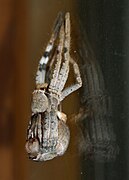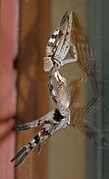
Huntsman spiders, members of the family Sparassidae, are known by this name because of their speed and mode of hunting. They are also called giant crab spiders because of their size and appearance. Larger species sometimes are referred to as wood spiders, because of their preference for woody places. In southern Africa the genus Palystes are known as rain spiders or lizard-eating spiders. Commonly they are confused with baboon spiders from the Mygalomorphae infraorder, which are not closely related.
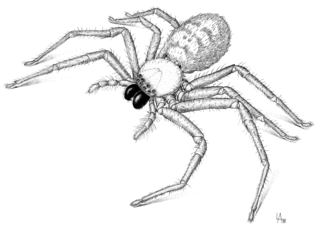
Delena cancerides, the flat huntsman or social huntsman or Avondale spider, is a large, brown huntsman spider native to Australia. It has been introduced to New Zealand, where it is sometimes known as the Avondale spider as they are commonly found in the suburb of Avondale, Auckland. This was the species used in the beginning of the 2002 movie Spider-Man, a part in Australian movie Napoleon and widely in Arachnophobia, and all films depict them as having a deadly venomous bite, but they are generally considered harmless to humans in real-life. It was first described by Charles Athanase Walckenaer in 1837.
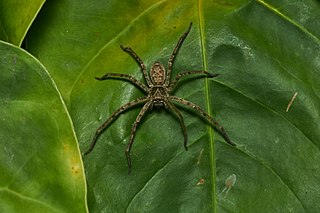
Heteropoda venatoria is a species of spider in the family Sparassidae, the huntsman spiders. It is native to the tropical regions of the world, and it is present in some subtropical areas as an introduced species. Its common names include giant crab spider, or cane spider.

Micrommata virescens, common name green huntsman spider, is a species of huntsman spiders belonging to the family Sparassidae.
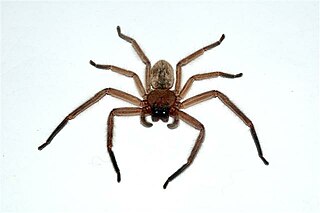
Delena is a genus of South Pacific huntsman spiders that was first described by Charles Athanase Walckenaer in 1837.

Tarantulas comprise a group of large and often ″hairy″ spiders of the family Theraphosidae. Currently, about 1,000 species have been identified. The term tarantula is usually used to describe members of the family Theraphosidae, although many other members of the same infraorder (Mygalomorphae) are commonly referred to as "tarantulas" or "false tarantulas". Some of the more common species have become popular in the exotic pet trade. Many New World species kept as pets have urticating hairs that can cause irritation to the skin, and in extreme cases, cause damage to the eyes.
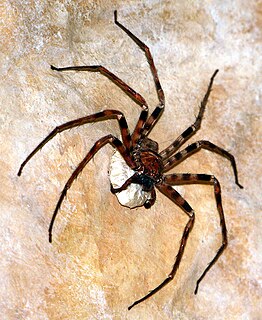
The giant huntsman spider, found in Laos, is a species of huntsman spider (Sparassidae), a family of large, fast spiders that actively hunt down prey. It is considered the world's largest spider by leg span, which can reach up to 30 cm (1 ft).

Heteropoda davidbowie is a species of huntsman spider of the genus Heteropoda. It was described from the Cameron Highlands District in peninsular Malaysia and named in honour of singer David Bowie.
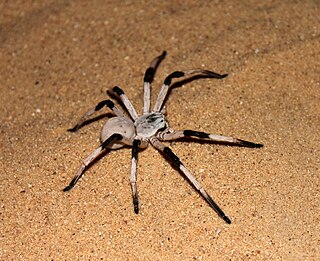
Cerbalus aravaensis is a huntsman spider found in the southern Arava Valley of Israel and Jordan. The species was first described by Gershom Levy of the Hebrew University of Jerusalem in 2007, though news agencies later reported it in 2010 as a new discovery by a team of biologists from the University of Haifa. The spider has a leg span of 14 centimetres (5.5 in), making it the largest member of the family Sparassidae in the Middle East. Males have a body length of 1.85–2.40 centimetres (0.73–0.94 in), while females' body length is 2.20–2.65 centimetres (0.87–1.04 in).
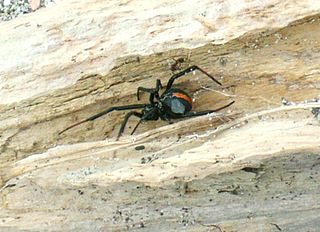
New Zealand has 1134 described spider species, with an estimated total fauna of 2000 species. Over 90 per cent are endemic, and the rest have been introduced through human activities or were natural wind-borne introductions.

Holconia is a genus of South Pacific huntsman spiders that was first described by Tamerlan Thorell in 1877. It was branched from Isopeda in 1990.
David B. Hirst is an arachnologist previously based at the South Australian Museum in Adelaide. He left the Museum on 22 February 2011. He has described more than 40 species and genera in the huntsman spider family, Sparassidae, and was regularly called on by New Zealand authorities to identify huntsman spiders that entered their country.

Palystes is a genus of huntsman spiders, commonly called rain spiders or lizard-eating spiders, occurring in Africa, India, Australia, and the Pacific. The most common and widespread species is P. superciliosus, found in South Africa, home to 12 species in the genus. The name Palystes is derived from either the Latin palaestes or the Greek palaistes, meaning "wrestler". The genus was first described by Ludwig Carl Christian Koch in 1875.

Isopeda is a genus of huntsman spiders that was first described by Ludwig Carl Christian Koch in 1875.

Micrommata ligurina is a species of huntsman spider. It was first described by Carl Ludwig Koch in 1845.
Sinopoda scurion is a species of huntsman spider discovered in 2012 in a Laotian cave. It has a leg span of about 6 centimetres (2.4 in) and a body span of about 12 millimetres (0.47 in). It is the first recorded huntsman spider to lack eyes. Due to its dark cave habitat, it has no requirement of vision for hunting.
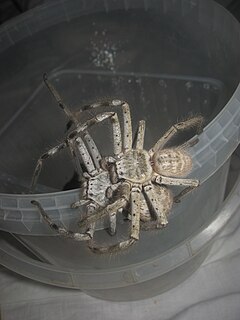
Holconia immanis, commonly known as the Sydney huntsman spider, is a species of huntsman spider found in eastern Australia.

Beregama is a genus of South Pacific huntsman spiders that was first described by D. B. Hirst in 1990.
Isopedella is a genus of huntsman spiders that was first described by D. B. Hirst in 1990.

Neosparassus is a genus of huntsman spiders first described by Henry Roughton Hogg in 1903. Members of this genus most closely resemble those of Heteropoda, except that the cephalothorax is high, peaking between the midpoint and the eyes, before sloping toward the back. This angle causes the front of these spiders to appear more prominent than it actually is.





